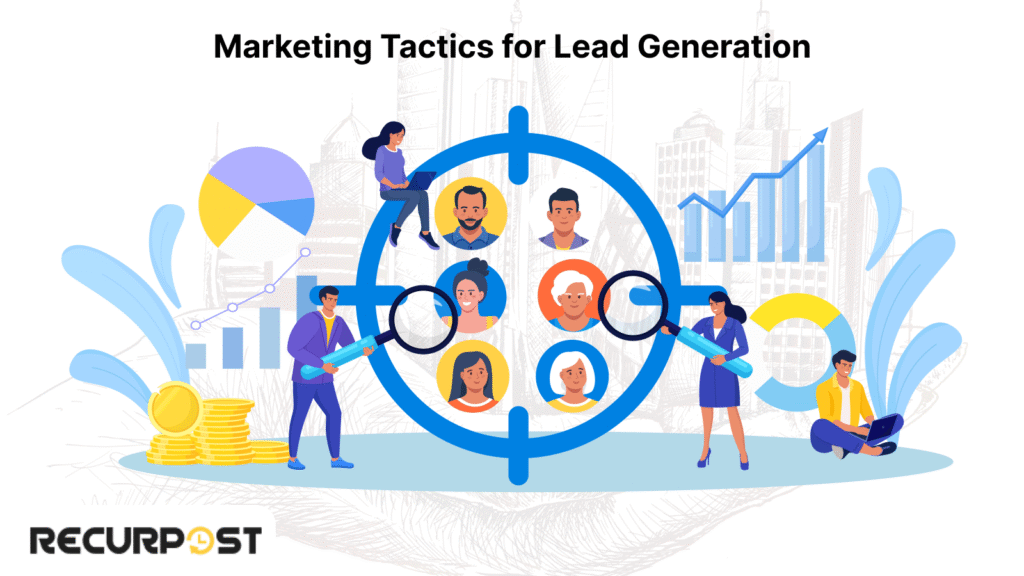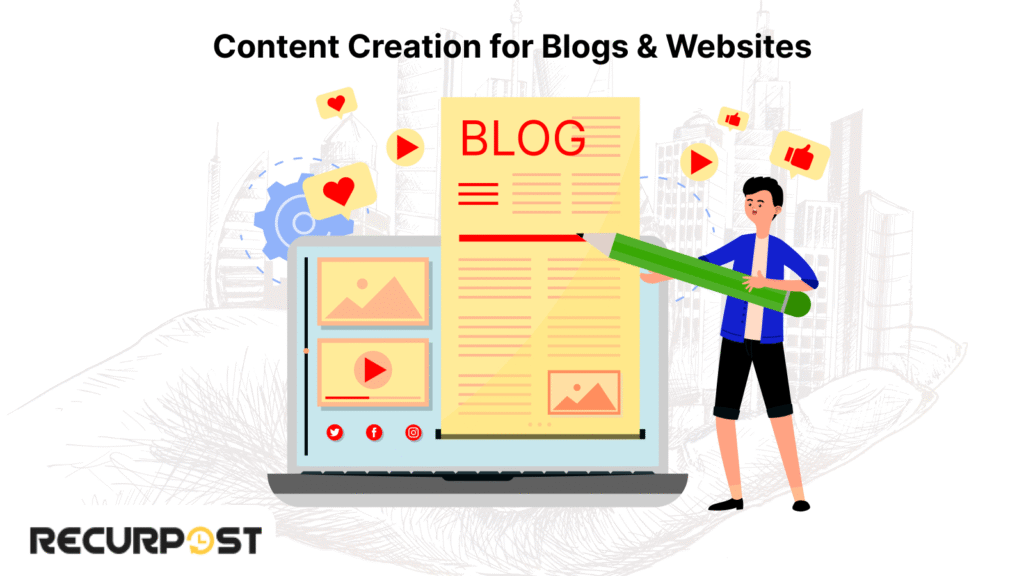Why Real Estate Content Marketing is Essential for Growth
If you’re in the real estate game, you know how competitive it can be. Every agent, agency, and freelancer vies for the attention of potential buyers and sellers. The best way to stand out? Real Estate Content Marketing.
Did you know that real estate businesses using content marketing generate 67% more leads at 33% lower costs. Whether you’re a real estate agent, part of an agency, or a freelancer in the industry, content marketing grows your business, builds relationships, and increases visibility.
With the right content, you build trust with potential clients, stay top-of-mind with past clients, and outshine competitors. This article shows how to use real estate content marketing effectively. From compelling blog posts to engaging videos, these tips maximize ROI and boost your business.
This guide walks you through actionable tips, real-life examples, and proven strategies for success in the real estate market.
Crafting a Winning Real Estate Content Marketing Strategy

A solid content marketing strategy is your best friend. Without one, you’re just hoping for a lucky break. But with a plan? You’ve got control over your marketing outcomes.
To get started, you’ll want to think about these key things:
The Importance of Strategy
In real estate marketing, failing to plan means planning to fail. Without a clear plan, your content lacks focus and fails to connect with your target audience.
Creating a strategy makes your marketing efforts cohesive, efficient, and purposeful. A good plan helps you know exactly what you’re doing, why you’re doing it, and how you’re going to measure success.
Conduct Competitor Analysis
Before creating content, examine what competitors are doing. Analyze what works for them and what’s missing in their content. This analysis reveals content gaps in your market..
If other real estate agencies focus only on property listings, a gap may exist for content educating buyers on the home-buying process or highlighting local neighborhoods. Spotting these gaps allows you to provide value that competitors don’t offer.
Steps to Build Your Content Strategy
Identifying Your Target Audience
Do you know who your ideal clients are? Whether you’re targeting first-time homebuyers, investors, or renters, understanding their needs, pain points, and desires is key. Knowing your audience makes your content more relevant and engaging.
Setting Clear Goals
Define what your content marketing should achieve. Whether increasing brand awareness, generating leads, or driving website traffic, clear goals enable measurement and maintain focus on objectives.
Creating a Content Calendar
A content calendar organizes and maintains consistency in your content. Planning posts in advance ensures the right content appears at the right time on the right channels, eliminating last-minute planning stress.
Content Types: The Variety You Need
Content types serve different purposes. You don’t want to rely on just one type of content; mixing it up will keep your audience engaged. Here’s a look at the most effective content types for real estate marketing:
- Blog Posts: Share valuable insights, tips, and market trends that your audience cares about. Blog posts help build trust and authority.
- Social Media Updates: Showcase property listings, client success stories, or market updates on social platforms like Instagram, Facebook, and LinkedIn. Check out the 100 real estate social media post ideas.
- Video Content: Property walkthroughs, virtual tours, or behind-the-scenes clips. Video is one of the most engaging forms of content.
- Newsletters: Keep potential and past clients updated with the latest market news, listings, and home buying tips.
Using a mix of these content types keeps your audience engaged, informed, and returning regularly.
Key Real Estate Marketing Tactics for Lead Generation

With your strategy in place, let’s explore tactics that generate leads. Your content should connect with potential clients and guide them toward decisions. Here’s how to use content to capture leads:
SEO for Real Estate Websites
Amazing content remains invisible if your website lacks search engine optimization. Search Engine Optimization (SEO) ensures your content reaches the right people.
Here’s how to do it:
- Local SEO: Most homebuyers are searching for properties in specific locations. Make sure your content is location-specific, using keywords like “homes for sale in [city name]” or “best neighborhoods in [location]”.
- Long-Tail Keywords: Use long-tail keywords like “affordable homes for first-time buyers” or “luxury homes with a pool in [location]”. These terms attract users who are closer to making a buying decision.
- Schema Markup for Listings: Adding schema markup to your property listings helps search engines understand the specifics of the property (price, location, type, etc.), making it easier for your listings to show up in search results.
Also, don’t forget mobile optimization. With 53% of real estate searches starting on mobile devices, your website needs to be fast and responsive for mobile users.
Social Media Marketing for Real Estate
Social media connects you with your audience and showcases your expertise. Here’s how to make the most of it:
- Crafting Engaging Posts: Instagram and Facebook are the go-to platforms for real estate. Share property photos, virtual tours, and behind-the-scenes content to show your personality and expertise.
- Pinterest Marketing: Pinterest is often overlooked in real estate, but it’s a fantastic platform for sharing visually appealing property listings and home décor ideas. People use Pinterest to dream, and you want your listings to be part of that dream.
- Instagram Stories & Facebook Ads: Use Instagram Stories to give quick property updates or behind-the-scenes looks. Facebook Ads are great for targeted campaigns, helping you reach the right demographic, whether it’s first-time buyers or high-end investors.
Video Marketing for Real Estate
Video builds connections and trust with potential clients. Here’s how to use video in your marketing efforts:
- Property Walkthroughs & Virtual Tours: These give potential buyers an in-depth look at the property without having to visit in person. They can be a game-changer, especially for out-of-town buyers.
- Podcast Marketing: While not as visual, podcasts are gaining traction in the real estate space. You can offer valuable insights into the market, provide tips for buyers and sellers, and even interview local experts to engage your audience.
- 360° Tours: Virtual reality and 360° property tours are growing in popularity. They give potential buyers an immersive experience and can greatly improve engagement, especially for high-end listings.
Email Marketing for Realtors
Email nurtures leads and maintains connections with your audience effectively. Use email through:
- Build an Email List: Start gathering email addresses from website visitors, past clients, and anyone who shows interest in your properties.
- Targeted Campaigns: Once you’ve got an email list, segment it by buyer type (e.g., first-time buyers, investors, sellers) and send targeted, relevant content. Whether it’s a market update, a new listing, or a home buying guide, make sure the content speaks to their needs.
- Email Automation: Automate follow-up emails for those who’ve shown interest in specific properties or services. Drip campaigns can keep potential clients engaged and move them along in the buying process.
Mastering Content Creation for Real Estate Blogs and Websites

With strategy and lead-generation tactics established, focus on creating content that attracts, engages, and converts visitors. Quality content sets you apart from competitors.
Creating SEO-Optimized Blog Posts
Blogging engages potential clients and demonstrates your expertise. Beyond writing, posts must be optimized for search engines.
Here’s how to make your blog posts stand out:
- Focus on SEO Keywords: Use location-based keywords and long-tail keywords throughout your posts. For example, a blog post titled “Top 5 Neighborhoods for First-Time Homebuyers in [City Name]” will catch the attention of both search engines and buyers.
- Write Attention-Grabbing Headlines: Headlines should be clear, compelling, and relevant. It should instantly answer a question or promise a solution (e.g., “How to Buy Your First Home in 5 Simple Steps”).
- Content Structure: Break your content into short paragraphs and use subheadings to make it scannable. People usually skim blog posts, so make it easy for them to find the information they need.
- Repurpose Content: One great piece of content can go a long way. Repurpose your blog posts into videos, social media updates, or email newsletters. For example, a detailed guide on “Understanding the Home-Buying Process” can be turned into an engaging YouTube video.
Creating Local Area Content
Local area content matters because people search for properties in specific locations. Information speaking directly to your community builds authority and connects with local buyers.
Here’s what to include:
- Neighborhood Guides: Write about the best neighborhoods in your area, highlight local amenities, schools, parks, and businesses. This content is highly searchable and valuable for potential buyers.
- School District Information: Families with kids will be particularly interested in school district information. Provide insights about the top schools and what makes them stand out.
- Local Business Spotlights: Feature local businesses in your area. Not only does this help foster community engagement, but it can also make your content more shareable.
Seasonal Content Planning
Real estate follows seasonal patterns. Winter buyers seek homes with fireplaces or indoor space, while summer buyers prefer outdoor features like pools or large backyards. Seasonal content maintains marketing relevance and timeliness.
Plan your content to match the season. Here’s a simple guide:
- Spring/Summer: Focus on outdoor living spaces, garden tips, and pool maintenance.
- Fall/Winter: Offer tips for winterizing a home or managing the buying process during colder months.
- Market Updates: Provide updates on the real estate market specific to the season, whether it’s lower inventory in the winter or high competition in the summer.
Internal Linking to Boost SEO
Internal linking is a simple but powerful SEO tactic. By linking to other relevant blog posts and pages on your site, you encourage users to spend more time on your website and explore more of your content. This also helps search engines better understand your site structure.
For example, if you write a post about the best home-buying tips, link to a page on your site that showcases your property listings or offers a downloadable checklist for first-time buyers.
Optimizing for Conversions
Ultimately, your goal is to convert visitors into clients. That means you need to turn your great content into something that encourages action.
Here’s how to optimize your content for conversions:
- Strong Calls-to-Action (CTAs): Make sure each piece of content has a clear CTA. Whether it’s “Schedule a Free Consultation”, “Get a Property Valuation”, or “Sign Up for Our Newsletter”, your CTA should be obvious and compelling.
- Engagement-Focused Content: Encourage readers to comment, share, or interact with your content. Ask questions, run polls, or invite them to share their thoughts. The more engaged your audience is, the more likely they are to become clients.
Lead Generation Through Real Estate Content Marketing

Lead generation drives successful real estate businesses. How can you convert browsers into leads? Content marketing bridges this gap. Here’s how to use content to generate and nurture leads effectively:
Understanding Lead Magnets
Lead magnets are resources offered in exchange for contact information. They attract prospects genuinely interested in your offerings. Lead magnets provide potential real estate clients with tangible value.
Here are some ideas for real estate lead magnets:
- Ebooks: Create an eBook on topics like “The Ultimate Guide to First-Time Homebuying” or “Top 10 Neighborhoods to Buy a Home in [City Name].”
- Market Reports: Provide insights into the local real estate market, including pricing trends, average home values, and buyer activity. These reports help potential buyers and investors make informed decisions.
- Home-Buying Checklists: Develop a downloadable checklist for first-time buyers or sellers. A checklist offers a simple, actionable tool that encourages users to provide their details in exchange for the download.
Create lead magnets relevant to your audience that solve specific buying or selling challenges.
Convert site visitors into leads. Here’s how:
- Landing Pages and Forms: Ensure that your lead magnets are linked to dedicated landing pages with simple, user-friendly forms. Keep your forms short—ask for just enough information to follow up, like name, email, and phone number.
- Chatbots for Instant Engagement: Adding a chatbot to your site can provide instant assistance to visitors. It can help answer questions, offer property suggestions, or even schedule consultations right away. This immediate engagement can help turn a curious visitor into a qualified lead.
Creating CTAs That Capture Leads
Place CTAs strategically throughout your content to guide visitors toward action. Effective CTAs include:
- Book a Free Consultation: This is great for visitors who are seriously considering buying or selling a home.
- Get Your Free Property Report: Offer this to users who want a personalized property valuation or insights into the local market.
- Sign Up for a Free Home-Buying Guide: First-time buyers may appreciate a guide that takes them step-by-step through the process.
Clear, direct, and compelling CTAs capture more leads.
Referral Programs: Encourage Sharing
Referral programs generate leads while building trust. Incentivize referrals to tap into broader networks of potential buyers and sellers.
Offer incentives for successful referrals, such as a gift card, a free home evaluation, or even a discount on future services. Referral programs leverage trusted word-of-mouth recommendations.
Paid Ads and Retargeting
Paid advertising generates leads from your content. Social media platforms like Facebook, Instagram, and Google Ads allow you to run targeted ad campaigns that reach specific demographics, such as first-time buyers or those interested in a specific neighborhood.
Additionally, retargeting ads can be used to reach visitors who have already interacted with your content but didn’t convert the first time. Retargeting keeps your brand in front of them and encourages them to return and take action.
Tracking and Measuring Success in Real Estate Content Marketing

How do you know if your content marketing efforts are paying off? Tracking and measuring success answers this question. Monitoring key metrics helps refine your strategy and improve underperforming areas.
Key Performance Indicators (KPIs)
Track success using Key Performance Indicators (KPIs) that measure marketing effectiveness. Here are a few KPIs you should be focusing on:
- Website Traffic: Are people visiting your site? Look at the number of visitors, pages per session, and how long they stay on your site. More traffic means your content is reaching a wider audience.
- Lead Conversion Rate: This is perhaps the most important metric. It tells you how many visitors are turning into leads. If your lead conversion rate is low, it could mean your content isn’t compelling enough or your CTAs need tweaking.
- Engagement Rate: Are people engaging with your content? Track likes, shares, comments, and clicks on your blog posts, videos, and social media updates. High engagement means your content resonates with your audience.
- ROI (Return on Investment): This is the ultimate metric, which is how much return you’re getting for every dollar spent. Track how many leads you’re generating and compare that to your marketing budget to see if your efforts are financially worthwhile.
These KPIs help pinpoint successes, failures, and necessary strategy adjustments.
Customer Journey Tracking
Content marketing guides prospects through the customer journey. This journey involves several stages, from the first touch (a blog post or social media post) to the final action (contacting you for more info or scheduling a consultation).
Using tools like Google Analytics and CRM software, you can track a prospect’s path to conversion. Identify engagement patterns to optimize content and follow-up processes.
Tools to Track Marketing Effectiveness
Tools to measure marketing effectiveness include:
- Google Analytics: This tool is a must for tracking website traffic, user behavior, and conversion rates. You can see which blog posts are driving the most traffic or which pages are leading to the most conversions.
- SEMrush: A great tool for tracking your SEO performance, SEMrush allows you to monitor your website’s rankings, backlinks, and keyword performance.
- HubSpot: This all-in-one CRM and marketing platform allows you to track lead activity, email campaigns, social media performance, and more. It’s perfect for understanding your leads’ journey and how content is influencing conversions.
- CRM Tools: Tools like Salesforce or Zoho allow you to track customer interactions, so you can monitor how well your leads are engaging with your content and how close they are to making a decision.
These tools provide insights for data-driven decisions to improve results.
Case Study: Real Estate Content Marketing Success in Action

Before you dive into these success stories, remember this: sharing content that feels useful and real can turn casual browsers into eager leads. Whether it’s clear guides on local markets or quick video tours of apartments, the right message at the right moment builds trust, and more inquiries follow. Here are two agencies that proved it.
1. Mike Bussey of Real NYC Apartments: TikTok Walk-throughs
Instead of paid ads, this agent posted short video tours of Manhattan flats on TikTok. By highlighting unique features and adding bite-sized market tips, videos reached wide audiences.
- Over 1,000 potential clients viewed his profile each month
- Regular, authentic walkthrough clips
- Rapid DMs from serious renters and buyers, thespruce.com
- 20,000 organic followers across TikTok, Instagram, and YouTube—no paid ads needed
- The top video earned over 300,000 likes, amplifying reach and trust
Using mobile-friendly video content on social media not only builds trust but also drives direct inquiries—no extra ad budget needed.
2. The Cari McGee Team: Blogging + SMS Prompts
A Seattle-based brokerage has kept a blog running since 2006, sharing local market insights, home-buying tips, and neighborhood guides. They paired every page with an SMS “ask a question” prompt powered by Leadferno.
- Website leads jumped 240% year-over-year
- $58 000 in gross commission came from SMS-captured leads
- 77.4% of new inquiries received replies in under 30 minutes, leadferno.com
This shows how pairing valuable blog content (which attracts search traffic) with a simple text-message call-to-action can multiply leads.
This case study proves that with a well-executed content marketing plan, real estate businesses can stand out in a crowded market and generate quality leads, all while improving their online visibility and reputation.
Building a Personal Brand as a Real Estate Agent

A strong personal brand builds your reputation and relationships with prospective buyers. A personal brand helps build trust with potential clients.
Why It Matters
A personal brand shares your expertise and values with your target market. 65% of potential buyers choose an agent based on trust and reputation. Your personal brand builds this essential trust.
Tips for Building Your Personal Brand
- Share Your Journey
Talk about how you got started, the lessons you’ve learned, and what motivates you. Sharing compelling stories about your experience, including tips on selling properties, helps clients connect with you on a deeper level.
- Be Active on Social Media
Use platforms like Instagram and LinkedIn to share your expertise, behind-the-scenes moments, and expert advice. Whether it’s about the latest market trends or home maintenance tips, engaging on social media strengthens your personal brand. It’s also a great marketing channel for showcasing your work and attracting new business.
- Offer Value
Share helpful content such as home maintenance tips, market updates, and neighborhood guides. These valuable insights position you as an expert and attract prospective buyers who trust your knowledge.
- Engage with Your Community
Attend local events, sponsor initiatives, and participate in community groups. It shows you’re invested in the area you serve and adds to your reputation as a knowledgeable agent in your target market. This community engagement is also a great way to expand your business focus and build lasting connections.
- Be Consistent
Consistency in your message, whether it’s through your website content, social media, or client interactions, helps reinforce your personal brand. By staying true to your values and delivering consistent expert advice, you’ll build trust and credibility with your audience.
Conclusion
Real estate content marketing can elevate your business. Success comes from consistently delivering valuable, engaging content that resonates with your target audience.
Key takeaways:
- A solid content marketing strategy helps guide your efforts, ensuring your marketing activities are purposeful and effective.
- Lead generation tactics like SEO, social media marketing, and video content are essential for reaching potential clients and turning them into leads.
- Content creation for blogs and websites ensures you’re engaging with both potential buyers and sellers while also boosting your SEO performance.
- Lead magnets, effective CTAs, and referral programs help you nurture relationships and convert visitors into clients.
- Finally, tracking your KPIs and measuring success helps you continuously improve and refine your marketing efforts to stay ahead of the competition.
These strategies will help grow your business through content marketing. Success requires persistence. Create valuable content consistently and adjust based on audience response.
Implementing these strategies leads to more leads, higher engagement, and business growth. A strong content marketing plan helps you stand out in the competitive real estate market.
Take action now. Create content for your target audience and grow your business.
Frequently Asked Questions
1. How do I start a real estate content marketing campaign?
Begin by identifying your target audience and setting clear goals. Create a content calendar to plan your posts across channels. Choose content formats that resonate with your audience, such as blog posts, social media updates, and videos. Stay consistent with your messaging and adjust based on performance.
2. What content should I create for real estate marketing?
Focus on educational content that helps your audience make informed decisions. Topics like home-buying tips, market trends, and neighborhood guides are valuable. Real estate blogs should also include success stories, local area content, and listings with detailed descriptions.
3. How do I generate leads through real estate content marketing?
Offer valuable resources such as market reports, home-buying checklists, or free consultations. Ensure you have strong calls-to-action (CTAs) on all your content, like “Book a Free Consultation” or “Get Your Free Property Report.” Lead magnets are a great way to capture information from interested prospects.
4. What are the best social media platforms for real estate content marketing?
Instagram and Facebook are ideal for sharing property photos, virtual tours, and client success stories. LinkedIn works well for B2B connections, while Pinterest can be great for sharing visually appealing property content. Each platform offers unique opportunities to engage with your audience.
5. How can I measure the success of my real estate content marketing strategy?
Track metrics such as website traffic, lead conversion rates, engagement on social media, and ROI. Tools like Google Analytics, SEMrush, and HubSpot can help monitor performance and make data-driven decisions. Keep track of where prospects are in their buyer journey and how your content is influencing their decisions.
6. How do I create content that appeals to both buyers and sellers?
Create content that speaks to the needs of both groups. For example, “Tips for Buyers & Sellers in a Competitive Market” can offer insights that benefit both parties. Highlight how your services can help each group at various stages of their journey, from buying tips to selling strategies.
7. What are the legal considerations when creating real estate content?
Ensure that all content complies with fair housing laws and accurately represents properties. Always include disclaimers and avoid misleading statements. Additionally, obtain consent before using any testimonials or third-party content, and make sure all information you provide is truthful and up-to-date.

As a passionate content writer, I love blending creativity with research to craft compelling narratives that inform, engage, and inspire. With a strong focus on user engagement and brand communication, I create content that resonates with the audience and drives meaningful interactions.
